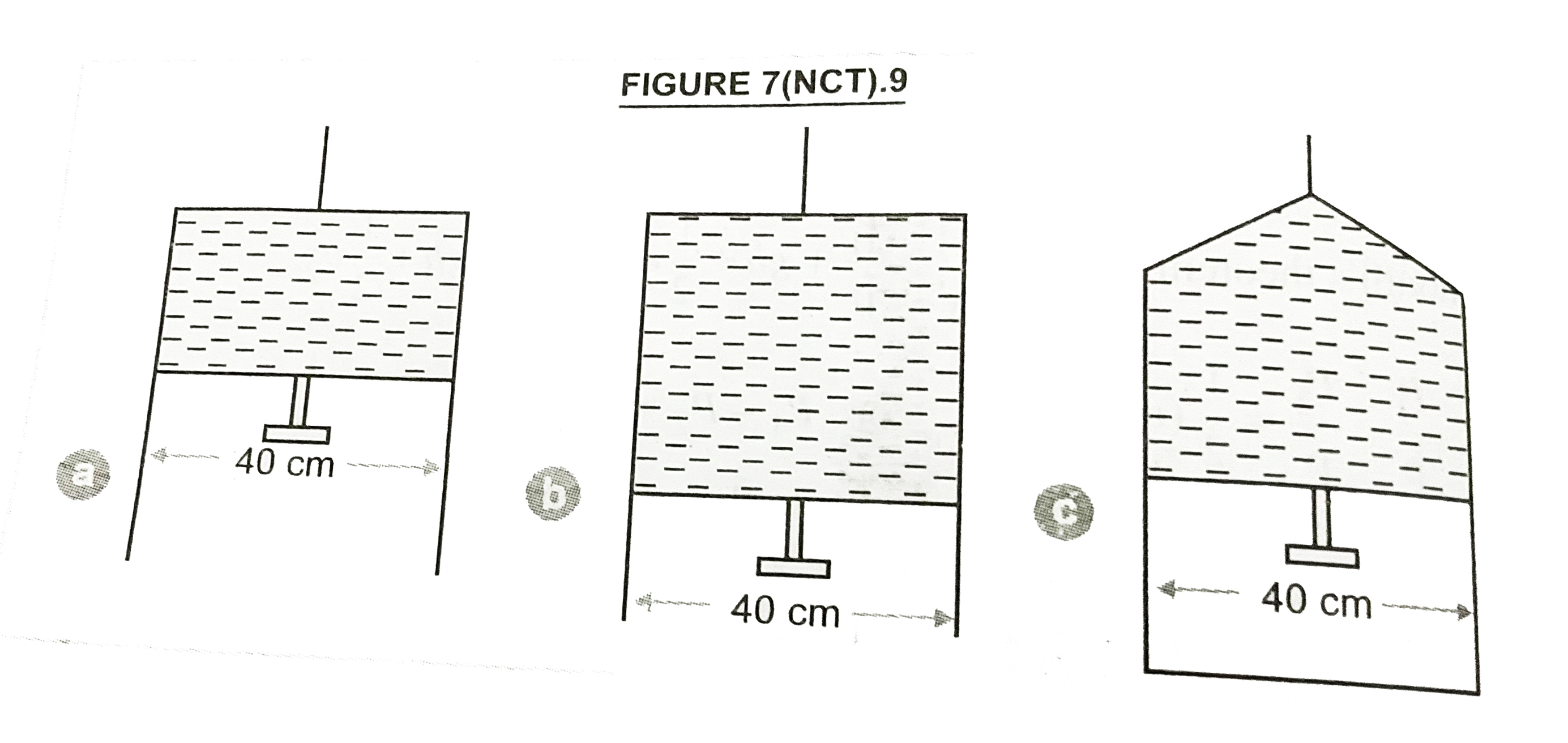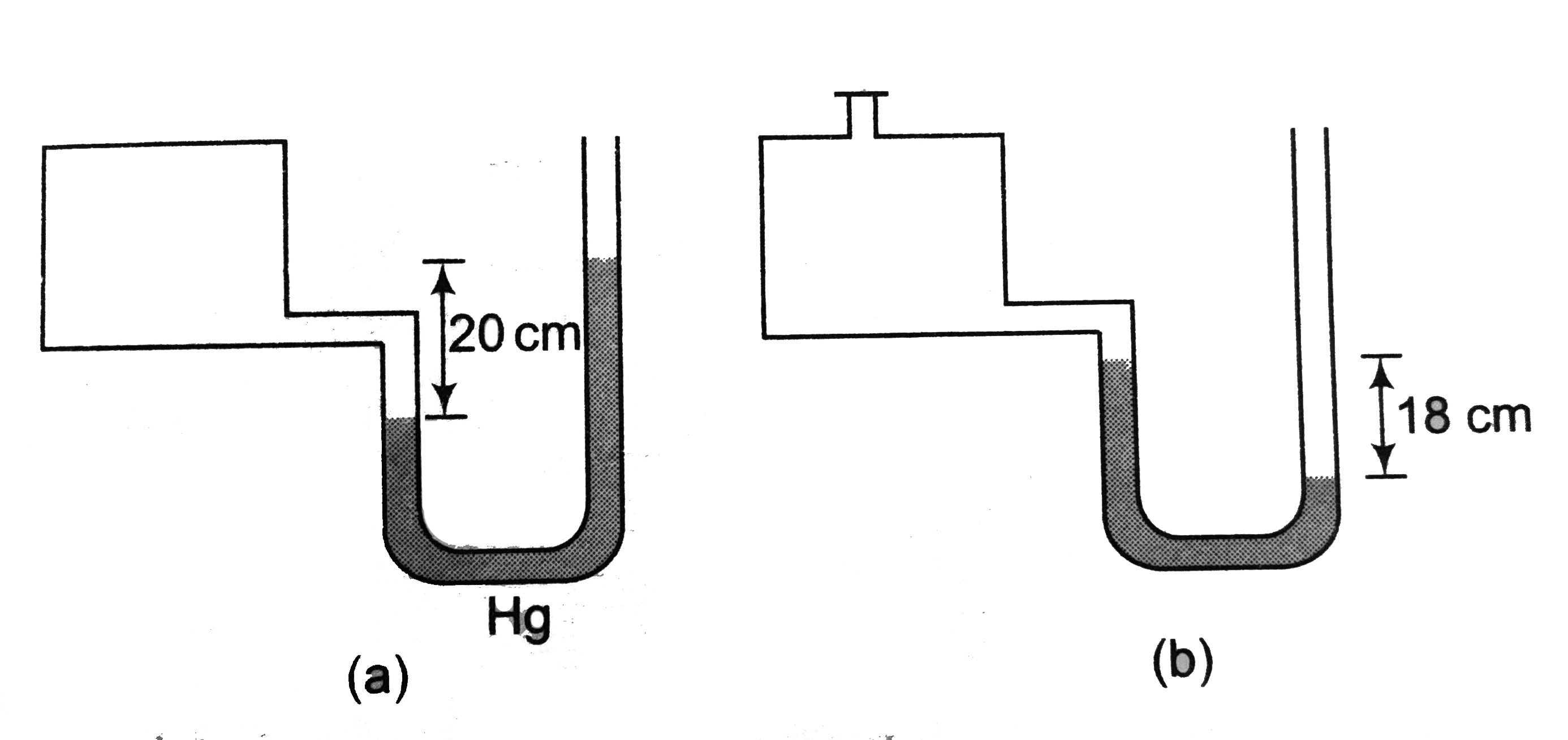Complete Solutions to EXERCISE of chapter MECHANICAL PROPERTIES OF FLUIDS of Class 11 book with complete answers and questions
| Class 11 | PHYSICS |
| Chapter | MECHANICAL PROPERTIES OF FLUIDS |
| NCERT | EXERCISE |
| Number Of Questions | 31 |
| Academic Year | 2023-24 |
Explain why (a) the blood pressure is humans is greater at the feet than at the brain.
(b) Atmospheric pressure at a height of about 6 km decreases to nearly half its value at the sea level through the 'height' of the atmospheric is more than 100 km.
(c) Hydrostatic pressure is a scalar quantity even though pressure is force divided by area , and force is a vector.02:31View SolutionExplain why
(a). The angle of contact of mercury with galss is obtuse, while that of water with glass is acute.
(b). Water on a clean glass surface tends to spread out while mercury on the same surface tends to form drops. (Put differently, water wets glass while mercury does not).
(c). Surface tension of a liquid is independent of the area of the surface
(d). Water with detergent disolved in it should have small angles of contact.
(e). A drop of liquid under no external forces is always spherical in shape.View SolutionFind in the blanks using the word (s) from the test appended with each statement.
(a) Surface tension of liquid generally …..with temperatures (increase//decreases).
(b) Viscosity of gases ….. With temperature, whereas viscosity of liquids ……with temperature. (increases//decreases)/
(c) For solids with elastic modulus of rigidity, the shearing force is proportional to .....while for fluids it is proportional to ....(shear strain//rate of shear strain).
(d) For a fluid in a steady flow, from .....(conservation of mass// Bernoulli's principle)
(e ) For the model of a plane in a wind tunnel, turbulence oc curs at a ...... speed for turbulence for an actual plane (greater//smaller)/05:09View SolutionExplain why
(a). To keep a piece of paper horizontal, you should blow over, not under, it
(b). When w try to close a water tap with our fingers, fast jets of water gush through the openings between our fingers
(c). The size of the needle of a syringe controls flow rate better than the thumb pressure exerted by a doctor while administering an injection
(d). A fluid flowing out of a small hole in a vessel results in a backward thrust on the vessel
(e). A spinning cricket ball in air does not follow a parabolic trajectory.View SolutionA 50 kg. girl wearing high heel shoes balance on a single heel. The heel is circular with a diameter 1 cm. what is the pressure exerted by the heel on the horizontal floor?
03:01View SolutionTorricelli's barometer used mercury. Pascal duplicated it using French wine of density `984 kg m^(-3)`. Determine the height of the wine column for normal atmospheric pressure.
03:43View SolutionA vertical off-shore structure is built to withstand a a maximum stress of `10^(9)Pa`. Is the structure suitabel for putting upon top of an oil well in bombay high? Take the depth of the sea to be roughly 3 km, and ignore oceam currents.
02:25View SolutionA hydraulic automobile lift is designed to lift cars with a maximum mass of 300 kg. the area of cross-section of the piston carrying the load is `425cm^(3)`. What maximum pressure would smaller piston have to bear?
03:08View SolutionA U tube contains water and methylated spirts separated by mercury columns in the two arms are in level with 10.0cm of water in one arm and 12.5 cm of spirit in the other. What is the relative density of spirit?
03:28View SolutionIf 15.0 cm of water and spirit each are further poured into the respective arms of the tube, what is the difference in the levels of mercury in the two arms? (Relative density of mercury = 13.6).
05:06View SolutionCan Bernoulli's equation be used to describe the flow of water through a rapid in a river? Explain.
00:44View SolutionDoes it matter if one uses gauge instead of absolute pressures in applying Bernoulli's equation. Explain.
05:15View SolutionGlycerine flows steadily through a horizontal tube of length 1.5m and radius 1.0 cm. if the amount of glycerine collected per second at one end is `4.0 xx 10^(-3) kg s^(-1)`, what is the pressuer difference between the two ends of the tube? (density of glycerine = `1.3xx10^(3)kgm^(-3)` and viscosity of glycerine =`0.83Ns m^(-2)`).
06:58View SolutionIn a test experiment on a model aeroplane in a wind tunnel, the flow speeds on the upper and lower surfaces of the wing are `70ms^(-1)` and `83ms^(-1)` respectively. What is the lift on the wing, if its area is `2.5m^(2)`? Take the density of air to be `1.3kgm^(-3)`
05:34View SolutionThe steady flow of (non-viscous) liquid. Which of the two figure is incorrect?why?
06:22View SolutionThe cylinderical tube of a spray pump has a cross-section of `8.0cm^(2)` one end of which has 40 fine holes each of diameter 1.0mm. If the liquid flow inside the tube is 1.5 m per minute, what is the speed of ejection of the liquid through the holes?
04:45View SolutionA U-shaped wire is dipped in a soap solution, and removed. A thin soap film formed between the wire and a light slider supports a weight of `1.5xx10^(-2)N` (which includes the small weigh of the slider). The length of the slider is 30cm. What is the surface tension of the film?
03:04View SolutionFig, shown a thin film supporting a small weight = `4.5xx10^(-2)N`. What is the weight supported by a film of the same liquid at the same temperature in fig. explain your answer physically.
 .02:44View Solution
.02:44View SolutionWhat is the pressure inside a drop of mercury of radius 3.0mm at room temperature? Surface tension of mercury at that temperature `(20^(@)C)` is `4.65xx10^(-1)Nm^(-1)`. The atmospheric pressure is `1.01xx10^(5)Pa`. Also give the excess pressure inside the drop.
02:33View SolutionWhat is the excess pressure inside a bubble of soap solution of radius 5.00mm, given that the surface tension of soap solution at the temperature `(20^(@)C)` is `2.50xx10^(-2)Nm^(-1)`? If an air bubble of the same dimension were formed at a depth of 40.0 cm inside a container containing the soap solution (of relative density 1.20), what would be the pressure inside the bubble? (1atm. is `1.01 xx 10^(5)Pa`).
04:31View SolutionA tank with a square base of area `1.0m^(2)` is divided by a vertical parition in the middle. The bottom of the partition has a small hinged door of area `20cm^(2)`. The tank is filled with water and an acid (of relative density 1.7) in the other, both to a height of `4.0m`. Compute to force necessary the force nec cessary to keep the door closed.
03:55View SolutionA manometer reads the pressure of a gas in a enclosure as shown in figure(a) When some of the gas is removed by a pump, the manometer reads as in (b). The liquid used in the manometers is mercury and the atmospheric pressure is `76 cm` of mercury.

(i) Give the absolute and gauge pressure of the gas in the enclosure for cases (a) and (b) in units of cm of mercury .
(ii) How would the level change in case (b) if `13.6 cm` of water are poured into the right limb of the manometer?05:30View SolutionTwo vessels have the same base area but differnent shapes. The first vessel takes twice the vloume of water that the second vessel requires to fill up to a paricular common height . Is the force exerted by water on the base of the vessel the same in the two case? If so, why do the vessels filled with water to that same height give different reading on a weighting scale ?
View SolutionDuring blood transfusion the needle is inserted in a vein where the gauge pressure is `2000Pa` . At what height must the blood container be placed so that blood may just enter the vein? Density of whole blood = `1.06xx10^(3)Kg//m^(3)`.
03:20View SolutionIn deriving Bernoulli's equation , we equated the workdone on the fluid in the tube to its change in the potential and kinetic energy (a) How does the pressure change as the fluid moves along the tube if dissipative forces are present ? (b) Do the dissipative forces becomes more important as the fluid velocity increase? Discuss qualitatively.
03:35View Solution(a) What is the largest average velocity of blood flow in an artery of radius `2xx10^(-3)m` if the flow must remian laminar?
(b) What is the corresponding flow rate? Take viscosity of blood to be `2.084xx10^(-3)Pa-s`. Density of blood is `1.06xx10^(3)kg//m^(3)`.04:01View SolutionA plane is in level flight at constant speed and each of its wings has an area of `25m^(2)`. If the speed of the air is `180km//h` over the upper wing surface, determine the plane's mass . (Take air density to be `1 kg//m^(3)`). `g=9.8m//s^(2)`.
04:45View SolutionIn Millikan's oil drop experiment, what is the terminal speed of a speed of a drop of radius `2.0 xx 10^(5)m` and density `1.2xx10^(3)m^(-3)`? Take the viscosity of air at the temperature of the experimental to be `1.8xx10^(-5)Nsm^(2)`. How much is the viscous force on the drop at that speed? Neglect buoyancy of the drop due to air.
03:31View SolutionMercury has an angle of contact equal to `140^(@)` with soda lime galss. A narrow tube of radius `1.00mm` made of this glass is dipped in a through containing mercury. By what amount does the mercury dip down in the tube relative to the mercury surface outside? Surface tension of mercury at the temperature of the experiment is `0.465 Nm^(-1)`. Density of mercury = `13.6xx10^(3) kg m^(-3)`.
04:06View SolutionTwo narrow bores of diameters 3.0mm and 6.0 mm are joined together to form a U-shaped tube open at both ends. If th U-tube contains water, what is the difference in its levels in the two limbs of the tube? Surface tension of water at the temperature of the experiment is `7.3xx10^(-2)Nm^(-1)`. Take the angle of contact to be zero. and density of water to be `1.0xx10^(3)kg//m^(3)`.
`(g=9.8 ms^(-2))`04:58View Solution(a). It is known that density `rho` of air decreases with height y as
`rho=rho_(0)e^(-y//y(_o))` ltb rgt where `p_(o)=1.25kgm^(-3)` is the density at sea level, and `y_(o)` is a constant. This density variation is called the law of atmospheres. Obtain this law assuming that the temperature of atmosphere remains a constant (isothermal conditions). Also assume that the value of g remains constant
(b). A large He balloon of volume `1425m^(3)` is used to lift a payload of 400 kg. Assume that the balloon maintains constant radius as it rises. How high does it rise?
[take `y_(o)=8000m and rho_(He)=0.18kgm^(-3)`]04:53View Solution
EXERCISE questions and complete solutions for chapter MECHANICAL PROPERTIES OF FLUIDS of NCERT PHYSICS(ENGLISH) of Class 11
